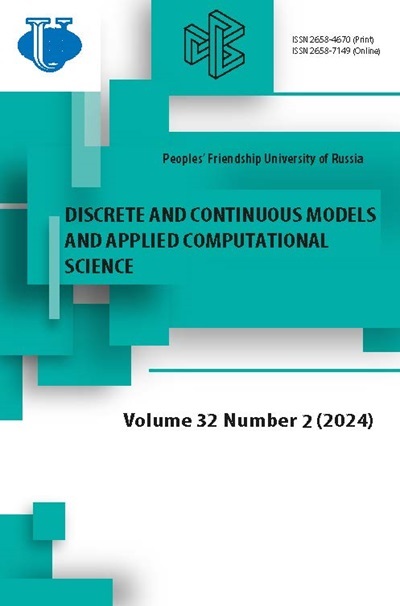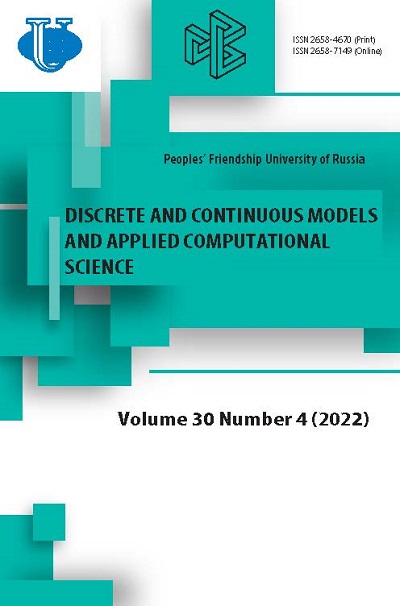Тензор проницаемостей в геометризованной теории Максвелла
- Авторы: Королькова А.В.1
-
Учреждения:
- Российский университет дружбы народов
- Выпуск: Том 30, № 4 (2022)
- Страницы: 305-317
- Раздел: Статьи
- URL: https://journals.rudn.ru/miph/article/view/33012
- DOI: https://doi.org/10.22363/2658-4670-2022-30-4-305-317
Цитировать
Полный текст
Аннотация
Считается, что основным препятствием к применению римановой геометризации уравнений Максвелла является недостаточное количество параметров, задающих геометризованную среду. При классическом описании уравнений электродинамики в среде используется тензор проницаемостей, имеющий 20 компонент. При римановой геометризации тензор проницаемостей строится из риманового метрического тензора, имеющего только 10 компонент. Предполагается, что данное несоответствие мешает применению римановой геометризации уравнений Максвелла. В статье предложено определить, действительно ли недостаток компонент является критическим для применения римановой геометризации уравнений Максвелла. Для определения области применимости римановой геометризации рассмотрены наиболее распространённые варианты электромагнитных сред. Для них выписана структура диэлектрической и магнитной проницаемостей, определено количество значащих компонент для этих тензоров. Показано, что практически все рассмотренные типы электромагнитных сред требуют менее десяти параметров для описания тензора проницаемостей. При римановой геометризации уравнений Максвелла критическим является требование единичного импеданса среды. Обойти данное ограничение возможно путём перехода от полных уравнений Максвелла к приближению геометрической оптики. Показано, что риманова геометризация уравнений Максвелла применима для большого разнообразия типов среды, но только для приближения геометрической оптики.
Об авторах
А. В. Королькова
Российский университет дружбы народов
Автор, ответственный за переписку.
Email: korolkova-av@rudn.ru
ORCID iD: 0000-0001-7141-7610
Docent, Candidate of Sciences in Physics and Mathematics, Associate Professor of Department of Applied Probability and Informatics
ул. Миклухо-Маклая, д. 6, Москва, 117198, РоссияСписок литературы
- F. C. Klein, “Ueber die sogenannte Nicht-Euklidische Geometrie,” German, in Gau und die Anfnge der nicht-euklidischen Geometrie, ser. Teubner-Archiv zur Mathematik, vol. 4, Wien: Springer-Verlag Wien, 1985, pp. 224-238. doi: 10.1007/978-3-7091-9511-6_5.
- F. C. Klein, “A comparative review of recent researches in geometry,” Bulletin of the American Mathematical Society, vol. 2, no. 10, pp. 215- 249, 1893. doi: 10.1090/S0002-9904-1893-00147-X.
- C. W. Misner, K. S. Thorne, and J. A. Wheeler, Gravitation. San Francisco: W. H. Freeman, 1973.
- I. Y. Tamm, “Crystal optics theory of relativity in connection with geometry biquadratic forms,” vol. 57, no. 3-4, pp. 209-240, 1925, in Russian.
- I. Y. Tamm, “Electrodynamics of an anisotropic medium in a special theory of relativity,” Russian Journal of Physical and Chemical Society. Part physical, vol. 56, no. 2-3, pp. 248-262, 1924, in Russian.
- L. I. Mandelstam and I. Y. Tamm, “Elektrodynamik der anisotropen Medien in der speziellen Relativittstheorie,” German, Mathematische Annalen, vol. 95, no. 1, pp. 154-160, 1925.
- J. Plebanski, “Electromagnetic waves in gravitational fields,” Physical Review, vol. 118, no. 5, pp. 1396-1408, 1960. doi: 10.1103/PhysRev. 118.1396.
- F. Felice, “On the gravitational field acting as an optical medium,” General Relativity and Gravitation, vol. 2, no. 4, pp. 347-357, 1971. doi: 10.1007/BF00758153.
- A. J. Ward and J. B. Pendry, “Refraction and geometry in Maxwell’s equations,” Journal of Modern Optics, vol. 43, no. 4, pp. 773-793, Apr. 1996. doi: 10.1080/09500349608232782.
- U. Leonhardt and T. G. Philbin, “Transformation optics and the geometry of light,” in Progress in Optics. 2009, vol. 53, ch. 2. doi: 10.1016/S0079-6638(08)00202-3.
- U. Leonhardt and T. G. Philbin, “General Relativity in Electrical Engineering,” vol. 8, 247, pp. 247.1-18, 2006. doi: 10.1088/13672630/8/10/247.
- D. S. Kulyabov, A. V. Korolkova, L. A. Sevastianov, M. N. Gevorkyan, and A. V. Demidova, “Geometrization of Maxwell’s Equations in the Construction of Optical Devices,” in Proceedings of SPIE. Saratov Fall Meeting 2016: Laser Physics and Photonics XVII and Computational Biophysics and Analysis of Biomedical Data III, vol. 10337, SPIE, 2017. doi: 10.1117/12.2267959.
- D. S. Kulyabov, A. V. Korolkova, and T. R. Velieva, “The Riemannian Geometry is not Sufficient for the Geometrization of the Maxwell’s Equations,” in Proceedings of SPIE. Saratov Fall Meeting 2017: Laser Physics and Photonics XVIII; and Computational Biophysics and Analysis of Biomedical Data IV, vol. 10717, Saratov: SPIE, Apr. 2018. doi: 10.1117/12.2315204.
- D. S. Kulyabov, A. V. Korolkova, T. R. Velieva, and A. V. Demidova, “Finslerian representation of the Maxwell equations,” in Proceedings of SPIE. Saratov Fall Meeting 2018: Laser Physics, Photonic Technologies, and Molecular Modeling, vol. 11066, Saratov: SPIE, Jun. 2019. doi: 10.1117/12.2525534.
- D. V. Sivukhin, “The international system of physical units,” Soviet Physics Uspekhi, vol. 22, no. 10, pp. 834-836, Oct. 1979. doi: 10.1070/pu1979v022n10abeh005711.
- D. S. Kulyabov, A. V. Korolkova, and V. I. Korolkov, “Maxwell’s equations in arbitrary coordinate system,” Bulletin of Peoples’ Friendship University of Russia. Series “Mathematics. Information Sciences. Physics”, no. 1, pp. 96-106, 2012.
- L. D. Landau, E. M. Lifshitz, and L. P. Pitaevskii, Course of Theoretical Physics, 2nd. Butterworth-Heinemann, 1984, vol. 8, 460 pp.
- S. Bolioli, “Bi-Isotropic and Bi-Anisotropic Media,” in Advances in Complex Electromagnetic Materials. NATO ASI Series. Springer Netherlands, 1997, vol. 28, ch. 3, pp. 33-51. doi: 10.1007/978-94-011-5734-6_3.
















